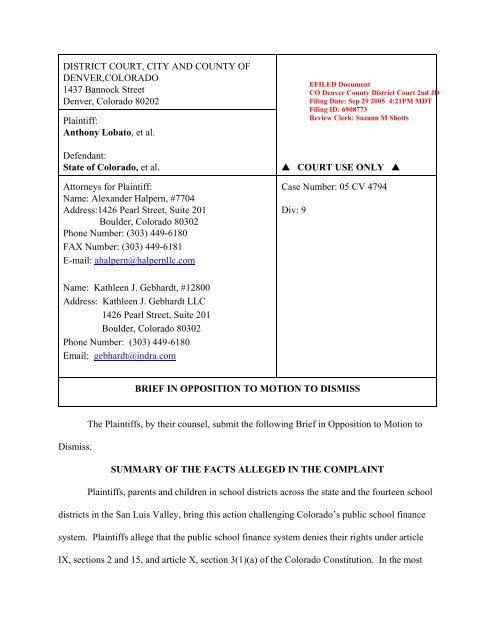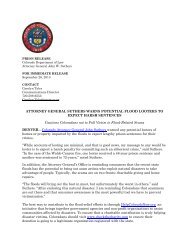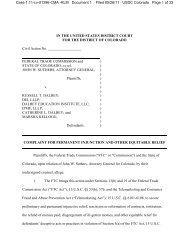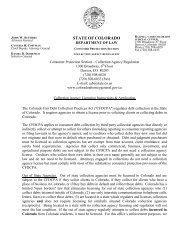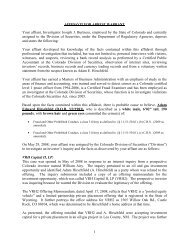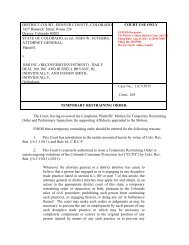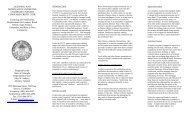brief in opposition to motion to dismiss - Colorado Attorney General
brief in opposition to motion to dismiss - Colorado Attorney General
brief in opposition to motion to dismiss - Colorado Attorney General
Create successful ePaper yourself
Turn your PDF publications into a flip-book with our unique Google optimized e-Paper software.
DISTRICT COURT, CITY AND COUNTY OFDENVER,COLORADO1437 Bannock StreetDenver, <strong>Colorado</strong> 80202Pla<strong>in</strong>tiff:Anthony Loba<strong>to</strong>, et al.Defendant:State of <strong>Colorado</strong>, et al.At<strong>to</strong>rneys for Pla<strong>in</strong>tiff:Name: Alexander Halpern, #7704Address:1426 Pearl Street, Suite 201Boulder, <strong>Colorado</strong> 80302Phone Number: (303) 449-6180FAX Number: (303) 449-6181E-mail: ahalpern@halpernllc.com• COURT USE ONLY •Case Number: 05 CV 4794Div: 9EFILED DocumentCO Denver County District Court 2nd JDFil<strong>in</strong>g Date: Sep 29 2005 4:21PM MDTFil<strong>in</strong>g ID: 6908773Review Clerk: Suzann M ShottsName: Kathleen J. Gebhardt, #12800Address: Kathleen J. Gebhardt LLC1426 Pearl Street, Suite 201Boulder, <strong>Colorado</strong> 80302Phone Number: (303) 449-6180Email: gebhardt@<strong>in</strong>dra.comBRIEF IN OPPOSITION TO MOTION TO DISMISSThe Pla<strong>in</strong>tiffs, by their counsel, submit the follow<strong>in</strong>g Brief <strong>in</strong> Opposition <strong>to</strong> Motion <strong>to</strong>Dismiss.SUMMARY OF THE FACTS ALLEGED IN THE COMPLAINTPla<strong>in</strong>tiffs, parents and children <strong>in</strong> school districts across the state and the fourteen schooldistricts <strong>in</strong> the San Luis Valley, br<strong>in</strong>g this action challeng<strong>in</strong>g <strong>Colorado</strong>’s public school f<strong>in</strong>ancesystem. Pla<strong>in</strong>tiffs allege that the public school f<strong>in</strong>ance system denies their rights under articleIX, sections 2 and 15, and article X, section 3(1)(a) of the <strong>Colorado</strong> Constitution. In the most
asic terms, Pla<strong>in</strong>tiffs contend that as a result of under-fund<strong>in</strong>g and irrational and unequalfund<strong>in</strong>g of public education, the State of <strong>Colorado</strong> is fail<strong>in</strong>g <strong>to</strong> provide a constitutionallyadequate, quality education; that the public school f<strong>in</strong>ance system fails <strong>to</strong> provide the f<strong>in</strong>ancialresources necessary for school districts <strong>to</strong> exercise their authority <strong>to</strong> control <strong>in</strong>struction <strong>in</strong> theirschools; and that radically unequal and irrational variations <strong>in</strong> property tax mill levies <strong>to</strong> fund thestate’s duty <strong>to</strong> provide an adequate public education constitute a state-wide, non-uniformproperty tax.In pert<strong>in</strong>ent part, article IX, section 2, of the <strong>Colorado</strong> Constitution (the EducationClause) mandates that the “general assembly shall . . . provide for the establishment andma<strong>in</strong>tenance of a thorough and uniform system of free public schools throughout the state.”Pla<strong>in</strong>tiffs contend that the Education Clause <strong>in</strong>cludes a substantive guarantee of aconstitutionally adequate, quality education for all school-age <strong>Colorado</strong> residents. The generalassembly has acknowledged this guarantee <strong>in</strong> legislation, e.g.:[S]ection 2 of article IX of the state constitution requires the general assembly <strong>to</strong> providefor the establishment and ma<strong>in</strong>tenance of a thorough and uniform system of free publicschools. The state therefore has an obligation <strong>to</strong> ensure that every student has a chance <strong>to</strong>attend a school that will provide an opportunity for a quality education. 1In order <strong>to</strong> fulfill its constitutional duty, the State must provide sufficient f<strong>in</strong>ancialresources for the public schools <strong>in</strong> a manner that is <strong>in</strong>tentionally, rationally, and demonstrablyrelated <strong>to</strong> the accomplishment of the qualitative mandate of the Education Clause. The generalassembly has also acknowledged this duty. The Public School F<strong>in</strong>ance Act of 1994 (PSFA), thepr<strong>in</strong>cipal source of education fund<strong>in</strong>g, “is enacted <strong>in</strong> furtherance of the general assembly’s dutyunder section 2 of article IX of the state constitution <strong>to</strong> provide for a thorough and uniform1COLO. REV. STAT. §22-30.5-301(1).2
system of public schools throughout the state . . . .” 2Fund<strong>in</strong>g for public education is derived from local taxes, state funds, and, <strong>to</strong> asignificantly lesser degree, federal funds. The PSFA sets the f<strong>in</strong>ancial base of support for eachschool district, referred <strong>to</strong> as its “<strong>to</strong>tal program fund<strong>in</strong>g.” School year 2005-06 <strong>to</strong>tal programfund<strong>in</strong>g is projected <strong>to</strong> be approximately $4.545 billion <strong>to</strong> provide services <strong>to</strong> some 733,000school children, for an average of $6,164 per pupil. Of this <strong>to</strong>tal, $2.835 billion (62.4 percent)will be provided by state fund<strong>in</strong>g and $1.710 billion (37.6 percent) from local school districtproperty taxes.The PSFA formula and fund<strong>in</strong>g levels that were established when it was amended <strong>in</strong>1994 were not based on an analytical determ<strong>in</strong>ation of the actual costs <strong>to</strong> provide aconstitutionally adequate, quality education, but merely rolled forward his<strong>to</strong>rical spend<strong>in</strong>gpatterns that were dis<strong>to</strong>rted by variations <strong>in</strong> local taxable property values and politicalcompromise. The problem was then magnified by years of under-fund<strong>in</strong>g. From 1994 until theimplementation of “Amendment 23” 3 <strong>in</strong> 2002, <strong>Colorado</strong> failed <strong>in</strong> every year <strong>to</strong> <strong>in</strong>crease PSFAfund<strong>in</strong>g at the m<strong>in</strong>imal rate necessary <strong>to</strong> defray <strong>in</strong>creased school district costs due <strong>to</strong> <strong>in</strong>flation.The result is a $3.4 billion cumulative shortfall <strong>in</strong> PSFA fund<strong>in</strong>g aga<strong>in</strong>st <strong>in</strong>flation alone over theten year period from 1994 <strong>to</strong> 2004.S<strong>in</strong>ce the 1994 amendments <strong>to</strong> the PSFA, the state has undertaken a comprehensivereform of the <strong>Colorado</strong> public education system, 4 and, <strong>in</strong> 2002 the State Board of Education2§22-54-102(1). See Board of County Comm’rs of Douglas County CO v. Ba<strong>in</strong>bridge, Inc., 929P.2d 621, 709 (Colo. 1997).3COLO. CONST., Art. IX, §17.4Key elements of education reform <strong>in</strong>clude the implementation of a state-wide standards-basededucation system <strong>in</strong>corporat<strong>in</strong>g manda<strong>to</strong>ry m<strong>in</strong>imum public school content standards andassociated student performance objectives; universal assessment of public school student3
(State Board) adopted the <strong>Colorado</strong> Consolidated State Plan (Consolidated State Plan) <strong>to</strong>conform <strong>to</strong> the requirements of the federal No Child Left Beh<strong>in</strong>d Act of 2001 (NCLB). 5 TheState has thereby established a system with standards, goals, objectives, methods, and results thatcreates a basel<strong>in</strong>e measure of whether the public school f<strong>in</strong>ance system provides sufficientf<strong>in</strong>ancial resources <strong>to</strong> meet the State’s obligation under the Education Clause.PSFA fund<strong>in</strong>g levels have never been adjusted <strong>to</strong> address the actual costs <strong>to</strong> provideevery student with a constitutionally adequate, quality education, or an education that meets thestandards and goals mandated by education reform legislation and the <strong>Colorado</strong> ConsolidatedState Plan. In fact, the PSFA fails <strong>to</strong> provide school districts with sufficient funds or fund<strong>in</strong>gability <strong>to</strong> meet the actual and foreseeable costs of educat<strong>in</strong>g their students. A statewide study bythe <strong>Colorado</strong> School F<strong>in</strong>ance Project (CSFP), conducted <strong>in</strong> accordance with nationally acceptedmethods of analysis, found that <strong>in</strong> the 2001-02 school year none of the 176 <strong>Colorado</strong> schooldistricts were able <strong>to</strong> raise and expend general operat<strong>in</strong>g funds at a level sufficient <strong>to</strong> provide aneducation that could meet the standards and mandates of the education reform legislation, muchless the Education Clause. The CSFP study found that <strong>in</strong> that year alone <strong>Colorado</strong> publicschools were under-funded with respect <strong>to</strong> meet<strong>in</strong>g the requirements of education reformlegislation by at least $500 million.proficiency with respect <strong>to</strong> these content standards by standardized test<strong>in</strong>g; comparative rat<strong>in</strong>g ofthe performance of students, schools, and school districts measured by the results of theseassessments; and school and school district accountability for student assessment results andprogress.5The Consolidated State Plan establishes a statewide accountability system for improv<strong>in</strong>g theacademic achievement of all students, identify<strong>in</strong>g and turn<strong>in</strong>g around low-perform<strong>in</strong>g schools,provid<strong>in</strong>g high-quality alternatives <strong>to</strong> students <strong>in</strong> low-perform<strong>in</strong>g schools, and improv<strong>in</strong>gaccountability, teach<strong>in</strong>g, and learn<strong>in</strong>g by the use of state assessment systems, all designed <strong>to</strong>ensure that students meet challeng<strong>in</strong>g state academic achievement and content standards and are4
Amendment 23 was not <strong>in</strong>tended <strong>to</strong> and has not remedied the fundamental failure <strong>to</strong>establish a thorough and uniform system of public education. Because the applicable <strong>in</strong>flationfac<strong>to</strong>r was only one-tenth of one percent (0.1%), <strong>in</strong> state fiscal year 2005-06, public schoolfund<strong>in</strong>g was <strong>in</strong>creased by only 1.1 percent. This <strong>in</strong>crease was based solely on the mechanicalapplication of the Amendment 23 formula and not on an analysis or even consideration of theactual cost of meet<strong>in</strong>g the mandates of the Education Clause, education reform legislation, or theConsolidated State Plan. This nom<strong>in</strong>al <strong>in</strong>crease was substantially below the actual <strong>in</strong>crease <strong>in</strong>fixed costs experienced by school districts and failed <strong>to</strong> provide sufficient additional fund<strong>in</strong>g <strong>to</strong>provide all <strong>Colorado</strong> students with the opportunity <strong>to</strong> obta<strong>in</strong> a constitutionally adequate, qualityeducation.The State has acknowledged that provid<strong>in</strong>g educational services <strong>to</strong> students from lowersocio-economic backgrounds, ethnic and racial m<strong>in</strong>orities, non-English speak<strong>in</strong>g families,students with disabilities, and gifted and talented students requires fund<strong>in</strong>g above the PSFA <strong>to</strong>talprogram amount. The State has also acknowledged the necessity <strong>to</strong> fund preschool and full-dayk<strong>in</strong>dergarten programs. The public school f<strong>in</strong>ance system attempts <strong>to</strong> address the costs ofserv<strong>in</strong>g these students through PSFA formula adjustments and “categorical” fund<strong>in</strong>g programs.However, <strong>in</strong> every case, the public school f<strong>in</strong>ance system fails <strong>to</strong> provide sufficient fund<strong>in</strong>g and<strong>to</strong> allocate fund<strong>in</strong>g <strong>in</strong> a manner rationally determ<strong>in</strong>ed <strong>to</strong> meet the actual costs of provid<strong>in</strong>g forthese educational needs and the rights of under-served student populations. As a result, thesestudents <strong>in</strong> particular do not receive an adequate education, and general operat<strong>in</strong>g funds<strong>in</strong>creas<strong>in</strong>g achievement <strong>in</strong> compliance with a schedule of annual yearly progress designed <strong>to</strong>accomplish one hundred percent academic proficiency by the school year 2013-14.5
necessary <strong>to</strong> provide an adequate education for all students must be diverted <strong>to</strong> meet thesespecial needs.Article IX, section 15 of the <strong>Colorado</strong> Constitution directs the general assembly <strong>to</strong>“provide for the organization of school districts of convenient size,” governed by locally electedboards of education and empowers the direc<strong>to</strong>rs of the local boards of education with the“control of <strong>in</strong>struction <strong>in</strong> the public schools of their respective districts.” Control of <strong>in</strong>structionby locally elected school boards is an <strong>in</strong>tegral component of a thorough and uniform system ofpublic education. 6The <strong>Colorado</strong> public school f<strong>in</strong>ance system’s failure <strong>to</strong> provide sufficientf<strong>in</strong>ancial resources <strong>to</strong> the school districts of the state <strong>to</strong> permit local boards of education <strong>to</strong>provide services, materials, and facilities necessary <strong>to</strong> meet the qualitative mandate of theEducation Clause is unconstitutional under article IX, sections 2 and 15 of the <strong>Colorado</strong>Constitution.Education reform legislation and the Consolidated State Plan have imposed <strong>in</strong>structionaland other substantive mandates upon school districts without analyz<strong>in</strong>g fund<strong>in</strong>g needs orprovid<strong>in</strong>g the means <strong>to</strong> fund the accomplishment of those mandates. This legislationsubstantially expanded the role of the State <strong>in</strong> areas of <strong>in</strong>struction, program, and educationalpolicy his<strong>to</strong>rically controlled by school districts; significantly <strong>in</strong>creased the test<strong>in</strong>g andadm<strong>in</strong>istrative tasks of school districts; and has imposed substantial <strong>in</strong>creases <strong>in</strong> the costs ofprovid<strong>in</strong>g a constitutionally adequate, quality education without provid<strong>in</strong>g school districts withsufficient fund<strong>in</strong>g or the means <strong>to</strong> obta<strong>in</strong> sufficient fund<strong>in</strong>g <strong>to</strong> meet those costs.School districts are controlled and strictly limited by the public school f<strong>in</strong>ance laws <strong>in</strong> the6 See Owens v. <strong>Colorado</strong> Congress of Parents, Teachers and Student, 92 P.3d 933, 938-9 (Colo.2004).6
evenues they can raise, receive, and expend <strong>to</strong> provide education programs <strong>to</strong> the students <strong>in</strong>their schools. The cost of provid<strong>in</strong>g a constitutionally adequate, quality education exceeds themaximum amount of fund<strong>in</strong>g that is available <strong>to</strong> school districts under the <strong>Colorado</strong> system ofpublic school f<strong>in</strong>ance. The public school f<strong>in</strong>ance system prevents school districts from obta<strong>in</strong><strong>in</strong>gadequate fund<strong>in</strong>g <strong>to</strong> meet the statu<strong>to</strong>ry and constitutional rights of their constituents, <strong>in</strong> violationof the constitutional authority vested <strong>in</strong> the local boards of education and the Education Clause.School district capital outlay expenditures <strong>in</strong> excess of PSFA capital reserve fund<strong>in</strong>g aref<strong>in</strong>anced by contract<strong>in</strong>g for bonded <strong>in</strong>debtedness. School district bonded debt can be paid onlyby revenues from local mill levies on the taxable property with<strong>in</strong> the boundaries of the district,and school districts are limited by statute <strong>in</strong> the amount of capital fund<strong>in</strong>g for which they maycontract. The system of f<strong>in</strong>anc<strong>in</strong>g capital outlay expenditures does not provide revenueaccord<strong>in</strong>g <strong>to</strong> the educational needs of students with<strong>in</strong> each district; does not provide sufficientfund<strong>in</strong>g for adequate facilities, technological <strong>in</strong>frastructure, and equipment; prevents schooldistricts from adequately address<strong>in</strong>g capital issues related <strong>to</strong> growth; contravenes theconstitutional mandate of local control, particularly <strong>in</strong> “property poor” school districts; and doesnot allocate the tax burden among <strong>Colorado</strong> citizens equally or uniformly.The value of taxable property per pupil varies widely among school districts. “Propertypoor” school districts <strong>in</strong> particular are unable <strong>to</strong> raise sufficient funds for capital outlay purposes<strong>to</strong> provide students with facilities necessary <strong>to</strong> assure a constitutionally adequate, qualityeducation. Taxpayers <strong>in</strong> property poor districts must pay significantly higher mill levies andbear a greater <strong>in</strong>dividual tax burden than similarly situated property owners <strong>in</strong> “propertywealthy” districts.7
ARGUMENTI. The Standard of ReviewDefendants must satisfy the demand<strong>in</strong>g standard of review for a Rule 12(b)(5) <strong>motion</strong>:A C.R.C.P. 12(b)(5) <strong>motion</strong> <strong>to</strong> <strong>dismiss</strong> for failure <strong>to</strong> state a claim upon which relief canbe granted serves as a test of the formal sufficiency of a pla<strong>in</strong>tiff’s compla<strong>in</strong>t. Dorman v.Petrol Aspen, 914 P.2d 909, 911 (Colo.1996). The chief function of a compla<strong>in</strong>t is <strong>to</strong>give a defendant notice of the transaction or occurrence that is the subject of a pla<strong>in</strong>tiff’slawsuit. Rosenthal v. Dean Witter Reynolds, Inc., 908 P.2d 1095, 1100 (Colo.1995). AC.R.C.P. 12(b)(5) <strong>motion</strong> <strong>to</strong> <strong>dismiss</strong> is looked upon with disfavor, and a compla<strong>in</strong>tshould not be <strong>dismiss</strong>ed unless it appears beyond a doubt that a pla<strong>in</strong>tiff can prove no se<strong>to</strong>f facts <strong>in</strong> support of her claim which would entitle her <strong>to</strong> relief. Id.; Dunlap v. Colo.Spr<strong>in</strong>gs Cablevision, Inc., 829 P.2d 1286, 1291 (Colo.1992). A compla<strong>in</strong>t should not be<strong>dismiss</strong>ed for failure <strong>to</strong> state a claim so long as the pla<strong>in</strong>tiff is entitled <strong>to</strong> some relief uponany theory of the law. Rosenthal, 908 P.2d at 1099; Dunlap, 829 P.2d at 1290.When review<strong>in</strong>g a <strong>motion</strong> <strong>to</strong> <strong>dismiss</strong> under C.R.C.P. 12(b)(5), all averments of materialfact must be accepted as true, and all of the allegations <strong>in</strong> the compla<strong>in</strong>t must be viewed<strong>in</strong> the light most favorable <strong>to</strong> the pla<strong>in</strong>tiff. Dorman, 914 P.2d at 911. Furthermore, whenreview<strong>in</strong>g a <strong>motion</strong> <strong>to</strong> <strong>dismiss</strong> a compla<strong>in</strong>t, the court may only consider matters statedwith<strong>in</strong> the compla<strong>in</strong>t itself, and may not consider <strong>in</strong>formation outside of the conf<strong>in</strong>es ofthat plead<strong>in</strong>g. Rosenthal, 908 P.2d at 1099.Public Service Co. of Colo. v. Van Wyk, 27 P.3d 377, 385-386 (Colo. 2001).II.Amendment 23 Does not Preclude Education Clause ClaimsIn 1876, the framers of the <strong>Colorado</strong> Constitution affirmed the people’s commitment <strong>to</strong>public education by mandat<strong>in</strong>g the establishment and ma<strong>in</strong>tenance of a thorough and uniformsystem of free public schools. Then, as now, thoughtful citizens recognized that publiceducation is the corners<strong>to</strong>ne of a modern democratic republic. 7 In November 2000, the7In a petition <strong>to</strong> the Constitutional Convention, a citizen’s group expressed the “belief that free,non-sectarian common schools are essential <strong>to</strong> the life and perpetuity of our form of government,and constitute the only security for a free, untrammeled ballot . . . .” Proceed<strong>in</strong>gs of theConstitutional Convention, at 277.8
elec<strong>to</strong>rate, react<strong>in</strong>g aga<strong>in</strong>st the debilitat<strong>in</strong>g effects of the TABOR Amendment 8 and <strong>in</strong> order <strong>to</strong>reverse the persistent failure of the general assembly <strong>to</strong> provide adequate fund<strong>in</strong>g for publiceducation, reaffirmed this commitment by adopt<strong>in</strong>g Amendment 23 through the <strong>in</strong>itiativeprocess. 9Now, the state agencies and officers who are pr<strong>in</strong>cipally responsible for fulfill<strong>in</strong>g theseeducational mandates cynically contend that by pass<strong>in</strong>g Amendment 23 the people actuallydim<strong>in</strong>ished the Education Clause and obviated the general assembly’s duty <strong>to</strong> determ<strong>in</strong>e andfund an adequate public education. While Amendment 23 <strong>in</strong>disputably sets a m<strong>in</strong>imum level ofannual <strong>in</strong>creases <strong>in</strong> fund<strong>in</strong>g for public education, there is no justification for argu<strong>in</strong>g that itthereby also def<strong>in</strong>es the amount of fund<strong>in</strong>g required <strong>to</strong> meet the qualitative standards of theEducation Clause.“[A] court’s duty <strong>in</strong> <strong>in</strong>terpret<strong>in</strong>g a constitutional amendment is <strong>to</strong> give effect <strong>to</strong> the willof the people adopt<strong>in</strong>g such amendment.” In re Great Outdoors <strong>Colorado</strong> Trust Fund, 913 P.2d533, 538 (Colo. 1996) (citation omitted). “To determ<strong>in</strong>e <strong>in</strong>tent, courts first exam<strong>in</strong>e the languageof the amendment and give words their pla<strong>in</strong> and commonly unders<strong>to</strong>od mean<strong>in</strong>g.” Zaner v. Cityof Brigh<strong>to</strong>n, 917 P.2d 280, 283 (Colo. 1996) (citations omitted). “When the language of anamendment is pla<strong>in</strong>, its mean<strong>in</strong>g clear, and no absurdity <strong>in</strong>volved, constitutional provisions mustbe declared and enforced as written.” In re Great Outdoors <strong>Colorado</strong> Trust Fund, supra(citation omitted).8The “Taxpayer’s Bill of Rights,” COLO. CONST., art. X, §20.9 With respect <strong>to</strong> the purposes of Amendment 23, See, An Analysis of the 2000 Statewide BallotProposals and Recommendations on Retention of Judges, Res. Pub. No. 475-6, LegislativeCouncil of the <strong>Colorado</strong> <strong>General</strong> Assembly (2000) (the Blue Book), at 14-15 (copy attached asExhibit A <strong>to</strong> Defendants’ Motion <strong>to</strong> Dismiss).9
Amendment 23 <strong>in</strong>cludes three pr<strong>in</strong>cipal provisions: a manda<strong>to</strong>ry, m<strong>in</strong>imum level ofannual <strong>in</strong>creases <strong>to</strong> public school fund<strong>in</strong>g; the creation and fund<strong>in</strong>g of a state education fund <strong>to</strong>support the mandated <strong>in</strong>creases and <strong>to</strong> address specified compell<strong>in</strong>g educational needs; and arequirement <strong>to</strong> ma<strong>in</strong>ta<strong>in</strong> a m<strong>in</strong>imum level of state public school fund<strong>in</strong>g effort. The purpose <strong>to</strong>establish m<strong>in</strong>imum annual fund<strong>in</strong>g <strong>in</strong>creases could not be more pla<strong>in</strong>ly expressed: subsection (1),titled “Purpose,” states that for fiscal years 2001-02 through 2010-11 PSFA and categoricalprogram fund<strong>in</strong>g “shall grow annually at least by the rate of <strong>in</strong>flation plus an additional onepercentage po<strong>in</strong>t,” and, thereafter “at a rate set by the general assembly that is at least equal <strong>to</strong>the rate of <strong>in</strong>flation.”Defendants seek <strong>to</strong> make the unambiguous language of Amendment 23 say someth<strong>in</strong>gthat it manifestly does not. Noth<strong>in</strong>g <strong>in</strong> the language of Amendment 23 remotely suggests apurpose <strong>to</strong> def<strong>in</strong>e the cost of a constitutionally adequate education. Amendment 23 does notexpressly refer <strong>to</strong>, amend, or supplant, much less dim<strong>in</strong>ish the qualitative mandate of theEducation Clause; nor does it attempt <strong>to</strong> def<strong>in</strong>e or limit the level or method of fund<strong>in</strong>g necessary<strong>to</strong> fulfill that mandate. Amendment 23 certa<strong>in</strong>ly does not state that the most m<strong>in</strong>imal level offund<strong>in</strong>g permitted by its terms also constitutes sufficient fund<strong>in</strong>g for purposes of the EducationClause. It is not the function of a court <strong>to</strong> search out and construe some unexpressed or<strong>in</strong>adequately expressed <strong>in</strong>tent of the elec<strong>to</strong>rate. See id., 913 P.2d at 540.Amendment 23 and the Education Clause coexist harmoniously <strong>in</strong> parallel. Defendantsdo not po<strong>in</strong>t <strong>to</strong> any language that is “reasonably susceptible <strong>to</strong> more than one <strong>in</strong>terpretation” orother textual ambiguity <strong>in</strong> Amendment 23 that would require the court <strong>to</strong> look beyond the text.See Zaner, supra, 917 P.2d at 283. The m<strong>in</strong>imum annual fund<strong>in</strong>g requirement advances thegoals of the Education Clause by partially mitigat<strong>in</strong>g the effects of TABOR on the ability of the10
State <strong>to</strong> fund a thorough and uniform system of public education. Its mean<strong>in</strong>g is clear anddevoid of conflict or absurdity, whether read <strong>in</strong> isolation or <strong>in</strong> the context of the rest of theconstitution.Ultimately, Defendants depend upon mischaracteriz<strong>in</strong>g Pla<strong>in</strong>tiffs’ claims. Pla<strong>in</strong>tiffs donot claim that the Education Clause mandates a “particular m<strong>in</strong>imum state-level contribution forfund<strong>in</strong>g public education services <strong>in</strong> <strong>Colorado</strong>.” 10Pla<strong>in</strong>tiffs seek neither a m<strong>in</strong>imum nor amaximum fund<strong>in</strong>g level, 11 but one that <strong>in</strong>tentionally, accurately, and fully provides fund<strong>in</strong>gsufficient <strong>to</strong> meet the qualitative standards of the Education Clause and permits school districts<strong>to</strong> fulfill their duty <strong>to</strong> control <strong>in</strong>struction <strong>in</strong> their schools.This mischaracterization is critical <strong>to</strong> Defendants’ argument; <strong>in</strong>deed, it is all the argumentthey have. Amendment 23 undoubtedly establishes a m<strong>in</strong>imum annual <strong>in</strong>crease <strong>in</strong> publiceducation fund<strong>in</strong>g that the legislature cannot fail <strong>to</strong> meet. Equally clearly, it does not establish afiscal safe harbor for the State or dim<strong>in</strong>ish the educational rights of the people by def<strong>in</strong><strong>in</strong>g athorough and uniform system of public education <strong>to</strong> be whatever education can be afforded at therate of 1994 spend<strong>in</strong>g plus an <strong>in</strong>flation fac<strong>to</strong>r. 12Based upon the unambiguous language ofAmendment 23 itself, Defendants’ argument fails for complete absence of textual support.10 Motion <strong>to</strong> Dismiss, at 4.11 Paragraph 228 of the Compla<strong>in</strong>t, <strong>to</strong> which Defendants’ cite, states that Pla<strong>in</strong>tiffs seek<strong>in</strong>junctive relief “[C]ompell<strong>in</strong>g the Defendants <strong>to</strong> establish, fund, and ma<strong>in</strong>ta<strong>in</strong> a thorough anduniform system of free public schools throughout the state that fulfills the qualitative mandate ofthe Education Clause and the rights guaranteed <strong>to</strong> the Pla<strong>in</strong>tiffs thereunder and that is <strong>in</strong> fullcompliance with the requirements of article IX, section 15, and article X, section 3(1)(a) of the<strong>Colorado</strong> Constitution.”12 The 1994 fund<strong>in</strong>g levels were not based upon a valid analysis of the actual costs of provid<strong>in</strong>g aconstitutionally adequate, quality education, and there is no basis <strong>to</strong> conclude that merelyres<strong>to</strong>r<strong>in</strong>g the 1994 fund<strong>in</strong>g levels would provide fund<strong>in</strong>g that meets the mandates of theEducation Clause.11
Defendants cite the Blue Book for the obvious proposition that by the addition ofAmendment 23, “the state constitution sets a m<strong>in</strong>imum <strong>in</strong>crease <strong>in</strong> fund<strong>in</strong>g.” Like theamendment itself, the Blue Book makes no reference <strong>to</strong> the Education Clause or <strong>to</strong> the fund<strong>in</strong>gof a thorough and uniform system of public education, and certa<strong>in</strong>ly does not <strong>in</strong>clude <strong>in</strong> thestatement of purposes one such as: “the proposed amendment will establish the required fund<strong>in</strong>glevel under article IX, section 2 of the constitution.”Defendants attempt <strong>to</strong> manufacture a conflict between the two constitutional provisionsand resolve it by amend<strong>in</strong>g or <strong>in</strong> effect repeal<strong>in</strong>g the Education Clause. “A conflict exists whenone provision authorizes what the other forbids or forbids what the other authorizes.” Bickel v.City of Boulder, 885 P.2d 215, 228-29 (1994). If their construction is accepted, Amendment 23implicitly amends the Education Clause by fix<strong>in</strong>g an annual dollar standard of compliance withits mandate. For Defendants, the Education Clause now reads: “the general assembly shall . . .provide for the establishment and ma<strong>in</strong>tenance of a thorough and uniform system of free publicschools throughout the state, provided that the costs of fund<strong>in</strong>g such system need not exceed theamount determ<strong>in</strong>ed by the formula set forth <strong>in</strong> article IX, section 17.” Such violence <strong>to</strong> theFramers’ mandate is contrary <strong>to</strong> the rules of construction:“Amendments by implication are not favored,” and we will not presume that the <strong>General</strong>Assembly <strong>in</strong>tended <strong>to</strong> change preexist<strong>in</strong>g law absent a clear expression or a manifest<strong>in</strong>consistency render<strong>in</strong>g harmonization unworkable.In re Marriage of Chalat, 112 P.3d 47, 55 (Colo. 2005) (citations omitted). Further:Repeals by implication are not favored. When two apparently contradic<strong>to</strong>ry statutesrelate <strong>to</strong> the same subject matter and two alternative constructions are possible, one ofwhich will result <strong>in</strong> giv<strong>in</strong>g effect <strong>to</strong> both statutes, while the other will <strong>in</strong>validate onestatute, we will adopt the <strong>in</strong>terpretation that gives effect <strong>to</strong> both statutes rather than theone which results <strong>in</strong> repeal of the earlier statute by implication. Here, the two sentenc<strong>in</strong>gprovisions are not <strong>in</strong> irreconcilable conflict. Rather they can sensibly be read <strong>to</strong>gether <strong>to</strong>give effect <strong>to</strong> both provisions.12
People v. District Court, 196 Colo. 249, 585 P.2d 913, 915 (Colo. 1978) (citations omitted).Even if there were an ambiguity <strong>in</strong> the relation between Amendment 23 and theEducation Clause, “where ambiguities exist, a court should favor a construction that harmonizesdifferent constitutional provisions rather than creates conflict.” In re Great Outdoors <strong>Colorado</strong>Trust Fund, supra, 913 P.2d at 538.A “cogent element” <strong>in</strong> our construction of general terms of the constitution is theconsideration of the object <strong>to</strong> be accomplished and the mischiefs <strong>to</strong> be avoided: we areobligated <strong>to</strong> construe the constitution <strong>in</strong> such a manner as will prevent an evasion of itslegitimate operation. Each provision of the constitution, both orig<strong>in</strong>al and amended,should be construed if possible <strong>to</strong> avoid any conflict between the different parts of theconstitution.<strong>Colorado</strong> Common Cause v. Bledsoe, 810 P.2d 201, 206 -207 (Colo. 1991) (citations omitted).The Education Clause and Amendment 23 both serve the <strong>in</strong>terests of public education,the former by direct<strong>in</strong>g the creation of a thorough and uniform system and the latter byprotect<strong>in</strong>g a m<strong>in</strong>imum fund<strong>in</strong>g level. There is neither an express nor an unavoidably implicit“conflict” between these naturally harmonious expressions of the public will. It is only whentwo constitutional provisions cannot be harmonized that rules of construction favor<strong>in</strong>g the later<strong>in</strong> time or the specific over the general enter the analysis. That is not the case here. The courtneed not be drawn <strong>in</strong><strong>to</strong> resolv<strong>in</strong>g a conflict that does not exist.III.THE EDUCATION CLAUSE CLAIMS ARE JUSTICIABIALEA. The Courts Have Subject Matter Jurisdiction over Actions Brought pursuant<strong>to</strong> the Education ClauseDefendants argue that statutes enacted by the legislature pursuant <strong>to</strong> the mandate of theEducation Clause are beyond constitutional review by the judiciary and that Coloradans such asthe Pla<strong>in</strong>tiffs who believe that the Education Clause creates rights <strong>in</strong> its named beneficiaries have13
no recourse <strong>to</strong> the courts <strong>to</strong> protect those rights. Defendants posit this argument on subjectmatter jurisdiction and nonjusticiability.As <strong>to</strong> the former, Defendants confound subject matter jurisdiction and nonjusticiability,fail<strong>in</strong>g <strong>to</strong> recognize the significant difference between the two. Powell v. McCormack, 395 U.S.486, 512 (1969); Baker v. Carr, 369 U.S. 186, 198 (1962). The district court and the <strong>Colorado</strong>Supreme Court pla<strong>in</strong>ly have jurisdiction <strong>to</strong> construe the state constitution. “Pursuant <strong>to</strong><strong>Colorado</strong> Constitution Article VI, section 1, the judicial branch of <strong>Colorado</strong> government isempowered <strong>to</strong> construe the constitution’s mean<strong>in</strong>g. . . . [T]he judiciary is the f<strong>in</strong>al arbiter of whatthe laws and the constitutions provide. Board of County Comm’rs v. Vail Associates, 19 P.3d1263, 1272 (Colo. 2001) (citations omitted). Indeed, “[o]nly the judicial branch holds theultimate authority <strong>to</strong> construe the constitution’s mean<strong>in</strong>g.” Wash<strong>in</strong>g<strong>to</strong>n County Bd. ofEqualization v. Petron Dev. Co., 109 P.3d 146, 149 (Colo. 2005).The <strong>Colorado</strong> Supreme Court has frequently exercised subject matter jurisdiction overEducation Clause claims. In Lujan v. <strong>Colorado</strong> State Bd. of Educ., 649 P.2d 1005 (Colo. 1982),the Court affirmed its function “<strong>to</strong> rule on the constitutionality of our state’s [school f<strong>in</strong>ance]system” and <strong>in</strong>terpreted the thorough and uniform provision not <strong>to</strong> “require that the <strong>General</strong>Assembly establish a central public school f<strong>in</strong>ance system restrict<strong>in</strong>g each school district <strong>to</strong>equal expenditures per student.” Id., 649 P.2d at 1025. The Lujan Court cited several cases <strong>in</strong>which it had previously construed the Education Clause. For example, <strong>in</strong> Marshall v. SchoolDist. RE #3 Morgan County, 191 Colo. 451, 553 P.2d 784 (1976), the Court held that theEducation Clause does not require school districts <strong>to</strong> provide students with free books. InFangman v. Moyers, 90 Colo. 308, 8 P.2d 762 (1932), the Court found that the Education Clauseassured the right of a child of a broken family <strong>to</strong> attend school <strong>in</strong> the district <strong>in</strong> which he resided14
with an <strong>in</strong>formal foster family.Therefore, there can be no debate that the courts have subject matter jurisdiction over theconstruction of the Education Clause and may, <strong>in</strong>deed, must review the constitutionality ofstatutes enacted <strong>in</strong> its name.B. The Court Should Review the Claims <strong>in</strong> this ActionThe further question is whether legislation address<strong>in</strong>g the qualitative guarantee of theEducation Clause <strong>in</strong> particular is “justiciable.” That is <strong>to</strong> say: is there some overrid<strong>in</strong>g reasonwhy the courts should refra<strong>in</strong> from perform<strong>in</strong>g their traditional role <strong>in</strong> this particular context?The analytical structure for this <strong>in</strong>quiry is as follows:In decid<strong>in</strong>g whether a case or controversy is justiciable, two determ<strong>in</strong>ations must bemade. We must first ascerta<strong>in</strong> “whether the claim presented and the relief sought are ofthe type which admit of judicial resolution.” [Powell v. McCormack, 395 U.S. 486, 516-17 (1969).] Second, we must determ<strong>in</strong>e whether the controversy presents anonjusticiable “political question”; i.e., a question “the resolution of which should beeschewed by the courts,” <strong>Colorado</strong> <strong>General</strong> Assembly v. Lamm, 704 P.2d 1371, 1378(Colo. 1985), because of the separation of powers doctr<strong>in</strong>e <strong>in</strong>herent <strong>in</strong> the <strong>Colorado</strong>Constitution, <strong>Colorado</strong> Common Cause v. Bledsoe, 810 P.2d 201, 205 (Colo. 1991). SeePowell, 395 U.S. at 517.Meyer v. Lamm, 846 P.2d 862, 872 (Colo. 1993).1. Lujan v. State Board of Education Affirms the Court’s Power <strong>to</strong>Construe the Education ClauseDefendants cite Lujan for the proposition that quality of education and school f<strong>in</strong>ance arepolicy questions beyond the competence of the judiciary. However, the Lujan Court pla<strong>in</strong>ly did<strong>in</strong>terpret the Education Clause and applied its <strong>in</strong>terpretation <strong>to</strong> the f<strong>in</strong>ance system <strong>in</strong> the contex<strong>to</strong>f the claims before it. The Court did not need <strong>to</strong> <strong>in</strong>terpret the phrase “thorough and uniform” <strong>in</strong>a comprehensive manner, and so held only that the mandate is “satisfied if thorough and uniformeducational opportunities are available through state action” and does not require that15
“educational expenditures per pupil <strong>in</strong> every school district be identical.” Lujan, 649 P.2d at1024-25.The claims decided <strong>in</strong> Lujan were critically different from those brought <strong>in</strong> this action.Lujan was an equal protection claim keyed <strong>to</strong> the argument that education was a “fundamentalright;” 13 that the school f<strong>in</strong>ance system was therefore subject <strong>to</strong> “strict scrut<strong>in</strong>y” review; that<strong>in</strong>equalities <strong>in</strong> expenditures per pupil existed between school districts due <strong>to</strong> variations <strong>in</strong> localproperty tax bases; and that s<strong>in</strong>ce the f<strong>in</strong>ance system could not be shown <strong>to</strong> be “necessarilyrelated <strong>to</strong> a compell<strong>in</strong>g governmental <strong>in</strong>terest,” it was unconstitutional. Lujan, 649 P.2d at 1013-14. The strategic fulcrum of pla<strong>in</strong>tiffs’ argument was that once spend<strong>in</strong>g <strong>in</strong>equalities wereproved, they were relieved of hav<strong>in</strong>g <strong>to</strong> show that differences <strong>in</strong> spend<strong>in</strong>g levels actually caused<strong>in</strong>equalities <strong>in</strong> educational opportunity, and the burden shifted <strong>to</strong> the defense <strong>to</strong> disprove thatproposition.The Supreme Court majority recognized that they were be<strong>in</strong>g f<strong>in</strong>essed <strong>in</strong><strong>to</strong> adopt<strong>in</strong>g as aconstitutional pr<strong>in</strong>ciple a hotly debated theory of educational policy:The method <strong>Colorado</strong> has chosen for fund<strong>in</strong>g public school education is the real focalpo<strong>in</strong>t of the challenge here. We note that appellees did not allege or prove that they arebe<strong>in</strong>g denied an educational opportunity. Appellees <strong>in</strong>stead argue that we should accept,amidst a rag<strong>in</strong>g controversy, that there is a direct correlation between school f<strong>in</strong>anc<strong>in</strong>gand educational quality and opportunity. We refuse, however, <strong>to</strong> venture <strong>in</strong><strong>to</strong> the realmof social policy under the guise that there is a fundamental right <strong>to</strong> education which callsupon us <strong>to</strong> f<strong>in</strong>d that equal educational opportunity requires equal expenditures for eachschool child. Even if we were <strong>to</strong> accept appellees’ contention, we would, nonetheless,refuse <strong>to</strong> adopt their a priori argument whereby a lack of complete uniformity <strong>in</strong> schoolfund<strong>in</strong>g between all of the school districts of <strong>Colorado</strong> necessarily leads <strong>to</strong> a violation ofthe equal protection laws <strong>in</strong> this state.Id., 649 P.2d at 1018 (emphasis added).13 This was the real focus of their Education Clause argument as well. The pla<strong>in</strong>tiffs also arguedunsuccessfully that “wealth” was a suspect classification for equal protection analysis, but that is16
In his concurr<strong>in</strong>g op<strong>in</strong>ion, Justice Erickson made very clear that the Court would notaccept an argument that amounted <strong>to</strong> a judicial f<strong>in</strong>d<strong>in</strong>g that either the equal protection clause orthe Education Clause mandated identical expenditures, services, and facilities throughout thestate:The decision of the trial court <strong>in</strong> this case rests upon the conclusion that money is thebasic and overrid<strong>in</strong>g criterion for adequate education. It is basic that funds must besupplied <strong>to</strong> provide for teachers, support staff, physical facilities, texts, supplies,transportation, and the myriad of other necessities <strong>in</strong> <strong>to</strong>day’s public educational system.However, I cannot adopt the premise that unless an identical amount of funds is expendedper pupil throughout the state, students <strong>in</strong> those districts receiv<strong>in</strong>g less than the districtwith the greatest expenditure per student are au<strong>to</strong>matically denied equal educationalopportunities.Moreover, I do not believe that Art. IX, sec. 2 of the <strong>Colorado</strong> Constitution guarantees <strong>to</strong>the children of this state a right <strong>to</strong> be educated <strong>in</strong> such a manner that all services andfacilities are identical throughout the State. In my view, such a centralized system ofeducation is not required by either the <strong>Colorado</strong> or United States Constitutions. Statedsimply, Art. IX, sec. 2 is a mandate <strong>to</strong> the State through the legislature <strong>to</strong> establish acomplete and uniform system of public education for <strong>Colorado</strong> elementary and secondaryschool students.Id., 649 P.2d at 1027 (emphasis added; citations omitted); see also, id., 649 P.2d at 1018(majority op<strong>in</strong>ion) (“The constitutional mandate which requires the <strong>General</strong> Assembly <strong>to</strong>establish ‘a thorough and uniform system of free public schools,’ is not a mandate for absoluteequality <strong>in</strong> educational services or expenditures.”).Lujan was an “equity” case seek<strong>in</strong>g equality of per pupil expenditure levels amongschool districts. This action is an “adequacy” case. 14Pla<strong>in</strong>tiffs contend that the EducationClause <strong>in</strong>cludes the substantive guarantee of a constitutionally adequate, quality education, andnot pert<strong>in</strong>ent here.14 For a review of the his<strong>to</strong>ry of school f<strong>in</strong>ance litigation discuss<strong>in</strong>g the difference between“equity” and “adequacy” claims, see School F<strong>in</strong>ance Adequacy as Vertical Equity, 28 U. Mich.J.L. Reform 493 (1995)..17
There is no basis <strong>to</strong> conclude that the term “thorough and uniform system of free publicschools” is beyond the comprehension of the judiciary. The idea that the Education Clause has asubstantive component is virtually <strong>in</strong>contestable. Lujan affirms that the phrase refers <strong>to</strong>educational “opportunities.” Id. In Fangman, the Supreme Court outl<strong>in</strong>ed the dimensions ofthose thorough and uniform opportunities, hold<strong>in</strong>g that by virtue of the Education Clause,statutes govern<strong>in</strong>g education should not be “narrowly and technically construed” <strong>to</strong> turn childrenaway from the school house “<strong>to</strong> grow up <strong>in</strong> idleness and ignorance,” but should be liberally andbroadly <strong>in</strong>terpreted” <strong>to</strong> further the purposes of educat<strong>in</strong>g children “<strong>to</strong> that degree that they cancare for themselves and act the part of <strong>in</strong>telligent citizens.” Fangman, supra, 8 P.2d at 311-312,quot<strong>in</strong>g McNish v. State, 74 Neb. 261, 263, 104 N.W. 186 (1905).In Lujan, the Court cites Pauley v. Kelley, 162 W.Va. 672, 255 S.E.2d 859 (1979) for a“thorough presentation of the education clauses <strong>in</strong> other states which are similar or identical <strong>to</strong><strong>Colorado</strong>’s ‘thorough and uniform’ requirement.” In that case, the West Virg<strong>in</strong>ia SupremeCourt, follow<strong>in</strong>g cus<strong>to</strong>mary standards of constitutional construction, def<strong>in</strong>ed both theconstitutional phrase “thorough and efficient” and identified its basic contents:We may now def<strong>in</strong>e a thorough and efficient system of schools: It develops, as best thestate of education expertise allows, the m<strong>in</strong>ds, bodies and social morality of its charges <strong>to</strong>prepare them for useful and happy occupations, recreation and citizenship, and does soeconomically.Legally recognized elements <strong>in</strong> this def<strong>in</strong>ition are development <strong>in</strong> every child <strong>to</strong> his orher capacity of (1) literacy; (2) ability <strong>to</strong> add, subtract, multiply and divide numbers; (3)knowledge of government <strong>to</strong> the extent that the child will be equipped as a citizen <strong>to</strong>make <strong>in</strong>formed choices among persons and issues that affect his own governance; (4)self-knowledge and knowledge of his or her <strong>to</strong>tal environment <strong>to</strong> allow the child <strong>to</strong><strong>in</strong>telligently choose life work -- <strong>to</strong> know his or her options; (5) work-tra<strong>in</strong><strong>in</strong>g andadvanced academic tra<strong>in</strong><strong>in</strong>g as the child may <strong>in</strong>telligently choose; (6) recreationalpursuits; (7) <strong>in</strong>terests <strong>in</strong> all creative arts, such as music, theatre, literature, and the visualarts; (8) social ethics, both behavioral and abstract, <strong>to</strong> facilitate compatibility with others<strong>in</strong> this society.19
Implicit are supportive services: (1) good physical facilities, <strong>in</strong>structional materials andpersonnel; (2) careful state and local supervision <strong>to</strong> prevent waste and <strong>to</strong> moni<strong>to</strong>r pupil,teacher and adm<strong>in</strong>istrative competency.255 S.E.2d at 877. 16These decisions are not <strong>in</strong> conflict with Lujan’s hold<strong>in</strong>g that the Education Clause doesnot mandate equal expenditure levels. The North Carol<strong>in</strong>a Supreme Court clearly dist<strong>in</strong>guishedbetween adequate fund<strong>in</strong>g <strong>to</strong> provide a sound basic education versus equal fund<strong>in</strong>g:Although we have concluded that the North Carol<strong>in</strong>a Constitution requires that access <strong>to</strong>a sound basic education be provided equally <strong>in</strong> every school district, we are conv<strong>in</strong>cedthat the equal opportunities clause . . . does not require substantially equal fund<strong>in</strong>g oreducational advantages <strong>in</strong> all school districts.Leandro v. State, 346 N.C. 346, 488 S.E.2d 249, 256 (1997). Accord, e.g., Roosevelt ElementarySch. Dist. No. 66 v. Bishop, 179 Ariz. 233, 877 P.2d 806, 814 (Ariz. 1994) (“[U]nits <strong>in</strong> ‘generaland uniform’ state systems need not be exactly the same, identical, or equal. Fund<strong>in</strong>gmechanisms that provide sufficient funds <strong>to</strong> educate children on substantially equal terms tend <strong>to</strong>satisfy the general and uniform requirement.”).There are a m<strong>in</strong>ority of states whose courts have decl<strong>in</strong>ed <strong>to</strong> <strong>in</strong>terpret their educationclauses because of nonjusticiability. Among them, Defendants emphasize Committee forEducational Rights v. Edgar, 174 Ill. 2d 1, 672 N.E.2d 1178 (1996). Edgar was predom<strong>in</strong>antlyan equity case; however, it did <strong>in</strong>clude an adequacy claim under the 1970 amendments <strong>to</strong> thestate’s education clause, which provided that “the State shall provide for an efficient system of16 Many other states have reached equivalent conclusions. E.g., Rose v. Council for BetterEduc., 790 S.W.2d, 186, 211-12 (Ken. 1989) (an “adequate education”); Roosevelt ElementarySch. Dist. No. 66 v. Bishop, 179 Ariz. 233, 877 P.2d 806, 814-15 (1994); DeRolph v. State, 78Ohio St. 3d. 193, 203-04, 1997 Ohio 84, 677 N.E.2d 733 (1996); Leandro v. State, 346 N.C. 346,488 S.E.2d 249, 254-57 (1997) (a “sound basic education”); Abbeville County Sch. Dist. v. State,335 S.C. 58, 515 S.E.2d 535, 539-40 (1999) (a “m<strong>in</strong>imally adequate education”).20
high quality public educational <strong>in</strong>stitutions and services.” ILL. CONST., art. X, §1. Id., 672N.E.2d at 1183. In f<strong>in</strong>d<strong>in</strong>g that it was not capable of def<strong>in</strong><strong>in</strong>g a “high quality education,” theIll<strong>in</strong>ois court relied upon recent legislative his<strong>to</strong>ry that demonstrated that “the framers of the1970 Constitution did not <strong>in</strong>tend <strong>to</strong> formulate any specific def<strong>in</strong>ition of ‘high quality,’ nor didthey anticipate that the concept would be def<strong>in</strong>ed by the courts.” Id., 672 N.E.2d at 1190. In thisrespect, Edgar is peculiarly a product of contemporary Ill<strong>in</strong>ois law and of limited persuasivevalue. 17 Courts have had no difficulty <strong>in</strong> def<strong>in</strong><strong>in</strong>g the pr<strong>in</strong>ciples embedded <strong>in</strong> their state’seducation clauses. They are also able <strong>to</strong> identify the fundamentally necessary elements of aneducation that must be provided <strong>to</strong> meet those pr<strong>in</strong>ciples, for example:The State must assure that some essentials are provided. Children are entitled <strong>to</strong>m<strong>in</strong>imally adequate physical facilities and classrooms which provide enough light, space,heat, and air <strong>to</strong> permit children <strong>to</strong> learn. Children should have access <strong>to</strong> m<strong>in</strong>imallyadequate <strong>in</strong>strumentalities of learn<strong>in</strong>g such as desks, chairs, pencils, and reasonablycurrent textbooks. Children are also entitled <strong>to</strong> m<strong>in</strong>imally adequate teach<strong>in</strong>g ofreasonably up-<strong>to</strong>-date basic curricula such as read<strong>in</strong>g, writ<strong>in</strong>g, mathematics, science, andsocial studies, by sufficient personnel adequately tra<strong>in</strong>ed <strong>to</strong> teach those subject areas.Campaign for Fiscal Equity v. State, 86 N.Y.2d 307; 655 N.E.2d 661; 86 N.Y.2d 307, 317(N.Y.Court Apps. 1995); see also DeRolph v. State, 78 Ohio St. 3d. 193, 208, 1997 Ohio 84, 677N.E.2d 733 (1996) (“Obviously, state fund<strong>in</strong>g of school districts cannot be considered adequate17 Justice Freeman, dissent<strong>in</strong>g from <strong>dismiss</strong>al of the adequacy claim lamented the result:Despite the <strong>in</strong>estimable value of a public school education, the majority foreverforecloses any judicial <strong>in</strong>quiry <strong>in</strong><strong>to</strong> whether the legislative and executive departments ofour state government conform <strong>to</strong> the education system provision. Regardless of howabysmal educational resources and opportunity become <strong>in</strong> poor school districts, and howsevere the disparities <strong>in</strong> educational quality grow among school districts, the judiciary isnow powerless <strong>to</strong> enforce the constitution.21
if the districts lack sufficient funds <strong>to</strong> provide students a safe and healthy learn<strong>in</strong>genvironment.”)The <strong>Colorado</strong> Supreme Court has <strong>in</strong>terpreted the mean<strong>in</strong>g of the Education Clause onnumerous occasions and has never shied away from its duty <strong>to</strong> enforce the constitution.Numerous other state courts have acted <strong>to</strong> enforce their state’s education clauses when calledupon. To accept Defendants’ approach would “essentially def<strong>in</strong>e the ambit of a constitutionalright by whatever a State Agency says it is.” Campaign for Fiscal Equity v. State of New York,187 Misc. 2d 1, 719 N.Y.S.2d 475, 484 (N.Y.Sup. 2001). This Court need not and should notabdicate the constitutional responsibility delegated <strong>to</strong> it by the Supreme Court.3. Education Reform Legislation Provides Legislative Standards andMeasures for Compliance with the Education ClauseThis is not a case <strong>in</strong> which the court must act <strong>in</strong> the absence of legislative <strong>in</strong>terpretationof the mean<strong>in</strong>g and content of the Education Clause. Education reform legislation enacted morethan a decade after Lujan is premised on the proposition that the Education Clause has aqualitative component and, <strong>in</strong>deed, creates a “fundamental right” <strong>to</strong> a free public education:Every resident of the state six years of age or older but under twenty-two years of age hasa fundamental right <strong>to</strong> a free public education that assures that such resident shall havethe opportunity <strong>to</strong> achieve the content standards adopted pursuant <strong>to</strong> this part 4 at aperformance level which is sufficient <strong>to</strong> allow such resident <strong>to</strong> become an effectivecitizen of <strong>Colorado</strong> and the United States, a productive member of the labor force, and asuccessful lifelong learner.COLO. REV. STAT. §22-7-403(2) (emphasis added).The legislature has def<strong>in</strong>ed the “acceptable performance level” necessary <strong>to</strong> meet theconstitutional right <strong>to</strong> an adequate education:672 N.E.2d at 1205, Freeman, J., concurr<strong>in</strong>g <strong>in</strong> part and dissent<strong>in</strong>g <strong>in</strong> part.22
The acceptable performance level . . . shall mean the student has the subject matterknowledge and analytical skills necessary <strong>to</strong> succeed at subsequent grade levels. Forgraduat<strong>in</strong>g students, such acceptable performance level shall mean the student has thesubject matter knowledge and analytical skills that all high school graduates should havefor democratic citizenship, responsible adulthood, postsecondary education, andproductive careers.Id., at §22-7-402(9) (emphasis added).The legislature has also mandated a comprehensive educational accountability program“<strong>to</strong> def<strong>in</strong>e and measure academic and safety quality <strong>in</strong> education and thus <strong>to</strong> help the publicschools of <strong>Colorado</strong> <strong>to</strong> achieve such quality and <strong>to</strong> expand the life opportunities and options ofthe students of this state,” which program is “designed <strong>to</strong> measure objectively the quality andefficiency of the educational programs offered by the public schools.” Id., at §22-7-102(1) and(2). 18 Thus, there are ample legislative and executive programs and regulations <strong>to</strong> permitmean<strong>in</strong>gful judicial review of both the sufficiency of the legislation, programs, and regulationsadopted <strong>to</strong> fulfill the mandate of the Education Clause, both <strong>in</strong> theory and <strong>in</strong> practice, and of theadequacy of the f<strong>in</strong>ancial resources provided <strong>to</strong> accomplish them. “[T]he Legislature hasrecognized its constitutional duty <strong>to</strong> provide for the education of the populace. Whether what theLegislature has done is sufficient <strong>to</strong> fulfill that constitutional duty is, of course, another matter.”McDuffy v. Secretary of Executive Office of Educ., 415 Mass. 545, 610-611, 615 N.E.2d 516,610 (1993).Education reform legislation alone provides a manageable basis for judicial review of theadequacy of school fund<strong>in</strong>g. In Kansas, where the state adopted a highly analogous system18The work<strong>in</strong>gs of the education reform legislation are described <strong>in</strong> some detail <strong>in</strong> Compla<strong>in</strong>t 84-103.23
judicial power; that the executive cannot exercise legislative or judicial power; and that thejudiciary cannot exercise executive or legislative power. It does not prescribe exact limits of therespective powers.” MacManus v. Love, 179 Colo. 218, 499 P.2d 609, 610 (1972).Pla<strong>in</strong>tiffs ask the court <strong>to</strong> exercise the traditional role of the judiciary. Judicial power<strong>in</strong>cludes “measur<strong>in</strong>g legislative enactments aga<strong>in</strong>st the standard of the constitution, and declar<strong>in</strong>gthem null and void if they are violative of the constitution.” <strong>Colorado</strong> Common Cause v.Bledsoe, 810 P.2d 201, 210 (Colo. 1991). This power is limited only <strong>to</strong> the extent that a courtmay not order the legislature “<strong>to</strong> convene, consider issues, or enact specific legislation.”Beauprez v. Avalos, 42 P.3d 642, 648 (Colo. 2002); Lucchesi v. State, 807 P.2d 1185, 1189(Colo.App. 1990) (“Colo. Const. art. III prohibits the courts from order<strong>in</strong>g the legislative brancheither <strong>to</strong> adopt, or not <strong>to</strong> adopt, specific legislation.”). Pla<strong>in</strong>tiffs ask the court <strong>to</strong> declare thepublic school f<strong>in</strong>ance system unconstitutional; Pla<strong>in</strong>tiffs do not ask the court <strong>to</strong> direct the<strong>General</strong> Assembly <strong>to</strong> convene or adopt specific legislation. If Defendants’ argument wereaccepted, courts could no longer overturn unconstitutional legislation if it meant that thelegislature might have <strong>to</strong> change the law <strong>to</strong> comply.Defendants’ argument that the court cannot rule on the constitutionality of a statute if itmight result <strong>in</strong> the appropriation of state funds is also wrong:[A] court has the power <strong>to</strong> enter a judgment that <strong>in</strong> order <strong>to</strong> be fully implemented mightrequire an additional appropriation by the <strong>General</strong> Assembly. . . . [Goebel v. <strong>Colorado</strong>Department of Institutions, 764 P.2d 785, 799 (Colo. 1988)] stands for precisely theproposition that . . . [t]he separation of powers argument advanced by the [Department ofCorrections] goes <strong>to</strong> the collection, and not <strong>to</strong> the entry, of the judgment. Consequently,we hold that it was not error for the trial court <strong>to</strong> enter a judgment aga<strong>in</strong>st the DOC that<strong>in</strong> order <strong>to</strong> be fully implemented would require an additional appropriation by the<strong>General</strong> Assembly, which the trial court would be powerless <strong>to</strong> order.State for Use of Dep’t of Corrections v. Pena, 855 P.2d 805, 809 (Colo. 1993) (emphasis added).26
Further, the general assembly’s “plenary power over appropriations applies only <strong>to</strong> ‘statemoneys.’” In re Interroga<strong>to</strong>ries Submitted by <strong>General</strong> Assembly on House Bill 01-1098, 88 P.3d1196, 1200 (Colo. 2004). Over one-third of PSFA fund<strong>in</strong>g comes from locally-raised propertytaxes which are constitutionally committed <strong>to</strong> the discretion of local school district boards ofeducation and not the state legislature or agencies. Owens, supra, 92 P.3d at 943.Courts outside <strong>Colorado</strong> that have decided school f<strong>in</strong>ance cases have deemed it necessaryand appropriate <strong>to</strong> reta<strong>in</strong> jurisdiction until the court has determ<strong>in</strong>ed that the Defendants havecomplied with its op<strong>in</strong>ion. E.g., Mon<strong>to</strong>y III, supra, 112 P.3d at 929, and cases cited at 929-31.While it is quite likely that the court will f<strong>in</strong>d the public school f<strong>in</strong>ance system unconstitutional,it is nevertheless uncerta<strong>in</strong>, and extended discussion of the issue of reta<strong>in</strong>ed jurisdiction ispremature at this stage of the proceed<strong>in</strong>gs. Cf., Stella v. Boulder County Dep’t of Social Services,92 P.3d 910, 914-15 (2004).6. The Claims Do Not Violate the TABOR AmendmentPla<strong>in</strong>tiffs’ seek declara<strong>to</strong>ry and <strong>in</strong>junctive relief; they do not request a court ordered<strong>in</strong>crease <strong>in</strong> overall State spend<strong>in</strong>g or taxation. “Declara<strong>to</strong>ry relief, if granted, ‘does not compel[][the legislature] <strong>to</strong> pass an act . . . nor restra<strong>in</strong>[] [it] from pass<strong>in</strong>g an act.” Bledsoe, supra, 810P.2d at 211, quot<strong>in</strong>g Lewis v. Denver City Waterworks Co., 19 Colo. 236, 238, 34 P.993, 994(1893). Defendants do not expla<strong>in</strong> how the requested judicial relief can violate any of TABOR’srestrictions on <strong>in</strong>creased debt, spend<strong>in</strong>g, or taxation. Just as there is no requested remedy thatwould violate separation of powers, there is none <strong>to</strong> conflict with TABOR.If the general assembly chooses <strong>to</strong> respond <strong>to</strong> a declara<strong>to</strong>ry judgment by <strong>in</strong>creas<strong>in</strong>gpublic school fund<strong>in</strong>g, there is no reason <strong>to</strong> conclude that such an <strong>in</strong>crease must violate TABOR.27
The general assembly can reprioritize state expenditures with<strong>in</strong> the overall spend<strong>in</strong>g capsimposed by TABOR. TABOR conta<strong>in</strong>s no restriction on shift<strong>in</strong>g state spend<strong>in</strong>g from oneprogram <strong>to</strong> another. Further, state-received damages are exempt from TABOR’s restrictions,and <strong>Colorado</strong> has received large sums of money from litigation, <strong>in</strong>clud<strong>in</strong>g the <strong>to</strong>bacco litigation.Or, of course, the <strong>General</strong> Assembly could secure approval for a tax or debt <strong>in</strong>crease from theelec<strong>to</strong>rate. 19Defendants misstate the basic premise of TABOR. TABOR does not require a vote ofthe people <strong>to</strong> authorize every <strong>in</strong>crease <strong>in</strong> governmental spend<strong>in</strong>g. Were that true, every budgetpassed by the general assembly would need <strong>to</strong> be approved by a vote of the people as everybudget conta<strong>in</strong>s <strong>in</strong>creases <strong>in</strong> governmental spend<strong>in</strong>g. Defendants cite no legal authority <strong>in</strong>support of such a far reach<strong>in</strong>g <strong>in</strong>terpretation of TABOR.Defendants argue that “courts that have become <strong>in</strong>volved <strong>in</strong> state educational plann<strong>in</strong>ghave demonstrated how difficult it is for the judiciary <strong>to</strong> prescribe any remedies for allegeddefects <strong>in</strong> a state’s educational system without any judicial standards <strong>to</strong> guide them.” 20Thisargument assumes that when this court orders a remedy, the general assembly will not comply.It is certa<strong>in</strong>ly premature <strong>to</strong> make such an assumption, and not a legitimate reason for this court <strong>to</strong>fail <strong>to</strong> adjudicate a constitutional claim.19Even accept<strong>in</strong>g Defendants’ assumption that the general assembly would have <strong>to</strong> <strong>in</strong>creaseoverall fund<strong>in</strong>g <strong>in</strong> response <strong>to</strong> a declara<strong>to</strong>ry judgment, they further assume that voters wouldreject such a proposal. This assumption reveals a further fallacy <strong>in</strong> Defendants’ position. If noconstitutional conflict arises when voters approve <strong>in</strong>creased spend<strong>in</strong>g, but only when they rejectsuch a proposal, the mean<strong>in</strong>g of the Education Clause depends on the outcome of a popular vote.The mandate of a constitutional provision cannot vary by popular will. The very purpose of aconstitution is <strong>to</strong> place certa<strong>in</strong> matters beyond the reach of rout<strong>in</strong>e vagaries of popular will andlodge their determ<strong>in</strong>ation and resolution <strong>in</strong> the hands of an <strong>in</strong>dependent judiciary.20Defendants’ <strong>brief</strong>, p. 2328
IV.THE SYSTEM OF PROPERTY TAXATION FOR SCHOOL FUNDINGVIOLATES THE UNIFORM TAXATION REQUIREMENT OF ARTICLE X,SECTION 3Defendants contend that the uniform taxation requirement is not applicable <strong>to</strong> the widelydisparate mill levies of districts throughout the state, argu<strong>in</strong>g that each district is free <strong>to</strong> set itsown rate. However, because districts' mill rates are determ<strong>in</strong>ed by the state, and are levied for acore state purpose, the Constitution's uniformity requirement is unavoidably triggered.“Article X of the <strong>Colorado</strong> Constitution structures and limits the legislature’s taxationpowers, provid<strong>in</strong>g the root fairness of treatment requisite <strong>to</strong> governmental legitimacy.” Board ofCounty Comm’rs v. Vail Associates, Inc., 19 P.3d 1263, 1273 (Colo. 2001). In pert<strong>in</strong>ent part,Section 3(1)(a) of Article X requires that “[e]ach property tax levy shall be uniform upon all realand personal property not exempt from taxation under this article located with<strong>in</strong> the terri<strong>to</strong>riallimits of the authority levy<strong>in</strong>g the tax.” This provision was “adopted <strong>in</strong> 1982 by referendum aspart of a more general overhaul of the constitution’s valuation and assessment provisions forproperty taxation. The court’s duty <strong>in</strong> <strong>in</strong>terpret<strong>in</strong>g a constitutional amendment is <strong>to</strong> give effect <strong>to</strong>the will of people.” Wash<strong>in</strong>g<strong>to</strong>n County Bd. of Equalization v. Petron Dev. Co., 109 P.3d 146,150 (Colo. 2005). The general assembly has the duty <strong>to</strong> “provide by law for an annual taxsufficient, with other resources, <strong>to</strong> defray the estimated expenses of the state government for eachfiscal year.” COLO. CONST., Art. X, §2 (emphasis added).Public education is a state purpose, and fund<strong>in</strong>g public education is a state obligation.See Florman v. School Dist. No. 11, El Paso County, 6 Colo. App., 40 P. 469, 470 (1895). InWilmore v. Annear, 100 Colo. 106, 65 P.2d 1433 (Colo. 1937), a taxpayer sought <strong>to</strong> enjo<strong>in</strong> the29
state audi<strong>to</strong>r and treasurer from issu<strong>in</strong>g and pay<strong>in</strong>g warrants <strong>to</strong> school districts, alleg<strong>in</strong>g that itwas unconstitutional <strong>to</strong> disburse money from the general revenues of the state <strong>to</strong> public schools.In uphold<strong>in</strong>g the <strong>dismiss</strong>al of pla<strong>in</strong>tiff’s compla<strong>in</strong>t, the <strong>Colorado</strong> Supreme Court held that:The establishment and f<strong>in</strong>ancial ma<strong>in</strong>tenance of the public schools of the state is thecarry<strong>in</strong>g out of a state and not a local or municipal purpose. The legislative departmenthad the constitutional power <strong>to</strong> make the appropriation by the act here <strong>in</strong> question. . . .By vest<strong>in</strong>g the power <strong>in</strong> districts <strong>to</strong> levy and collect taxes for the support of the school orschools <strong>in</strong> such districts, the state was but adopt<strong>in</strong>g a means for carry<strong>in</strong>g out its purposes.Id., 65 P.2d at 1437 (emphasis added).School tax levies are <strong>in</strong> fact State taxes and are subject <strong>to</strong> the uniformity requirement ofArticle X, §3(1)(a). The public school f<strong>in</strong>ance system <strong>in</strong>corporates state and local sources offund<strong>in</strong>g <strong>in</strong> the PSFA 21 and relies exclusively on local fund<strong>in</strong>g for capital construction. 22In bothcases, local property taxes are capped by legislation. 23 Although property taxes are nom<strong>in</strong>allyraised by the school districts, their purpose is <strong>to</strong> fund the State’s constitutional obligation <strong>to</strong>establish and ma<strong>in</strong>ta<strong>in</strong> a thorough and uniform system of public schools, and they are <strong>in</strong> factstate property tax levies. The State mandates the mill levies through the statu<strong>to</strong>ry fund<strong>in</strong>glimitations. Because the State fails <strong>to</strong> provide sufficient fund<strong>in</strong>g or the means <strong>to</strong> obta<strong>in</strong> sufficientfund<strong>in</strong>g, the “gross fund<strong>in</strong>g capacity” of the public school f<strong>in</strong>ance system, i.e., the statu<strong>to</strong>rilyfixed <strong>to</strong>talamount of funds that can be raised, is depleted, and school districts do not have any real tax<strong>in</strong>gdiscretion.21 See Compla<strong>in</strong>t 120-24.22See Compla<strong>in</strong>t 170-71.30
School districts exercise no discretion over the amount of the mill levy for the localshare, which is fixed by statute. Each year, the State <strong>in</strong>forms the school districts what their localmill levy will be for the upcom<strong>in</strong>g budget year, and the school districts develop and adopt theirannual budgets with<strong>in</strong> those limits. Follow<strong>in</strong>g adjustments based on local assessed valuationsand district pupil counts, the <strong>Colorado</strong> Department of Education certifies the f<strong>in</strong>al mill levy <strong>to</strong>the school districts by December 10 of each year. The districts then certify the mill levy <strong>to</strong> thecounty or counties <strong>in</strong> which they are situated, and the county commissioners levy the tax. COLO.REV. STAT. § 39-1-111(1). School districts have no control over the amount of the mill levy andare not the government that levies and collects the taxes. To call a school district a “tax<strong>in</strong>gauthority” <strong>in</strong> this context dis<strong>to</strong>rts the mean<strong>in</strong>g of “authority” past all reasonable limits. 24In Claremont School District v. Governor, 142 N.H. 462, 703 A.2d 1353 (1997), the NewHampshire Supreme Court addressed the issue of which entity is the tax<strong>in</strong>g authority forproperty taxes levied <strong>to</strong> support public schools. As <strong>in</strong> <strong>Colorado</strong>, New Hampshire public schoolsreceived their fund<strong>in</strong>g from local property taxes, direct legislative appropriations, and federalaid. Property taxes contributed <strong>to</strong> between 74 and 89 percent of the <strong>to</strong>tal school revenue. TheNew Hampshire constitution required that taxes be reasonable and “<strong>in</strong> due proportion.” Thepla<strong>in</strong>tiffs argued that the <strong>to</strong>tal value of property subject <strong>to</strong> taxation for local school revenuevaried among the cities and <strong>to</strong>wns of New Hampshire. The state argued that the school tax was alocal tax and thus met the constitutional requirement of reasonability and proportionality. Inrul<strong>in</strong>g that the system of unequal mill levies violated that state’s constitution, the NewHampshire Supreme Court ruled:23 See Compla<strong>in</strong>t 122 and 171.31
There is noth<strong>in</strong>g fair or just about tax<strong>in</strong>g a home or other real estate <strong>in</strong> one <strong>to</strong>wn at fourtimes the rate that similar property is taxes <strong>in</strong> another <strong>to</strong>wn <strong>to</strong> fulfill the same purpose ofmeet<strong>in</strong>g the State’s educational duty. Compell<strong>in</strong>g taxpayers from property-poor districts<strong>to</strong> pay higher tax rates and thereby contribute disproportionate sums <strong>to</strong> fund education isunreasonable. Children who live <strong>in</strong> poor and rich district have the same right <strong>to</strong> aconstitutionally adequate public education. Regardless of whether exist<strong>in</strong>g Stateeducational standards meet the test for constitutional adequacy, the record demonstratesthat a number of pla<strong>in</strong>tiff communities are unable <strong>to</strong> meet exist<strong>in</strong>g standards despiteassess<strong>in</strong>g disproportionate and unreasonable taxes.Id., 703 A.2d at 1357.In 1994, the PSFA was amended with the purpose of equaliz<strong>in</strong>g local property tax milllevies across the State. When adopted, the state and local contributions <strong>to</strong> the PFSA wereapproximately equal. S<strong>in</strong>ce then, the state share has substantially <strong>in</strong>creased and local mill levieshave become widely unequal. By 2003, the state share had <strong>in</strong>creased <strong>to</strong> over sixty percent of the<strong>to</strong>tal fund<strong>in</strong>g. 25In 1991, 133 of 176 school districts, represent<strong>in</strong>g the large majority of thestate’s population, levied a uniform property of 40.080 mills. 26In 2004-05, school district milllevies for their PSFA <strong>to</strong>tal program ranged from 3.738 <strong>to</strong> 40.080, with a statewide average of23.812. 27 .As a result of variations <strong>in</strong> mill levies between school districts, property taxes are notuniform across the state and district by district. For example, the Primero and Hoehne SchoolDistricts are both located <strong>in</strong> rural Las Animas County. Nearly 95 percent of the assessedvaluation <strong>in</strong> Primero is <strong>in</strong> oil and gas properties, and it now has the lowest school operat<strong>in</strong>g levy<strong>in</strong> the state.24 No statu<strong>to</strong>ry def<strong>in</strong>ition of “tax<strong>in</strong>g authority’ is found <strong>in</strong> the PFSA. The Random HouseCollege Dictionary def<strong>in</strong>es an authority as one with “the power <strong>to</strong> judge, act or command.”25 Compla<strong>in</strong>t at 184.26Compla<strong>in</strong>t at 180.32
SchoolDistrictHome ValueSchoolF<strong>in</strong>ance MillLevySchoolF<strong>in</strong>ancePropertyTaxesOtherSchool MillLeviesTotalPropertyTaxes <strong>to</strong>SchoolsPrimero $100,000 2.725 $21.69 0.308 $24.14Hoehne $100,000 26.008 $207.02 2.936 $230.39Similarly, <strong>in</strong> El Paso County, Hanover School District’s mill levy is 9.067 and the next highestmill levy for the other six rural El Paso School Districts is 23.571 <strong>in</strong> the Miami-Yoder SchoolDistrict. In each case, the result is equivalent variations <strong>in</strong> property taxes.Another result of the general decl<strong>in</strong>e and grow<strong>in</strong>g disparity <strong>in</strong> mill levy rates, manyschool districts have dim<strong>in</strong>ished the local contribution <strong>to</strong> their budgets, thereby reduc<strong>in</strong>g theirability <strong>to</strong> exercise local fiscal control. The state share <strong>in</strong> many Pla<strong>in</strong>tiff School Districts is morethan n<strong>in</strong>ety percent of their <strong>to</strong>tal program, leav<strong>in</strong>g very little local money for these districts.Legislative Council, Memo <strong>to</strong> Members of Interim Committee on School F<strong>in</strong>ance, August 2,2005, relevant portions attached as Exhibit 1. Defendants concede that “control over localproperty tax revenue is an <strong>in</strong>tegral part of local control under the Education Article of the<strong>Colorado</strong> Constitution.” 28The Defendants reliance on <strong>Colorado</strong> Dep’t of Social Services v. Board of CountyComm’rs of Pueblo County, 697 P.2d 1 (Colo. 1985) is misplaced. The provision of publicassistance programs is not a constitutionally mandated service, and the structure for payment ofpublic assistance programs is vastly different from that used <strong>in</strong> fund<strong>in</strong>g public schools. Just as <strong>in</strong>Pueblo Jr. College Dist. v. Donner, 154 Colo. 26, 387 P.2d 727 (1963), school districts have nodiscretion <strong>to</strong> set the amount of their mill levies, and their function <strong>in</strong> the tax<strong>in</strong>g process is purelym<strong>in</strong>isterial. Id., 387 P.2d at 730.27 Compla<strong>in</strong>t at 183.33
Defendants offer revenues raised <strong>in</strong> excess of <strong>to</strong>tal program as an example of localdiscretion. Section 22-54-107.5 once authorized additional local revenues for a supplementalcost of liv<strong>in</strong>g adjustment, but that statute expired <strong>in</strong> 2002. This provision had very limitedapplication, <strong>in</strong> any case, be<strong>in</strong>g applicable exclusively <strong>to</strong> communities where the cost of liv<strong>in</strong>gwas very high, such as Summit and Eagle Counties.Defendants also refer <strong>to</strong> the possibility of voter mill levy overrides, argu<strong>in</strong>g <strong>in</strong>correctlythat school districts are free <strong>to</strong> raise and expend local property tax revenue <strong>in</strong> excess of thedistrict’s <strong>to</strong>tal program should they so choose. School districts may not simply choose <strong>to</strong> raiseand expend local property tax revenue without an authoriz<strong>in</strong>g vote of the people <strong>in</strong> theirrespective districts, 29 and mill levy override revenue is capped at twenty percent of the district’s<strong>to</strong>tal program. 30Mill levy overrides are not equalized under the PSFA, and so suffer from thesame <strong>in</strong>firmity as the property tax revenue collected <strong>to</strong> support the PSFA. In many of thePla<strong>in</strong>tiff school districts, mill levies are much higher than the state average, property values arelow, and personal <strong>in</strong>comes are low, so pass<strong>in</strong>g a mill levy override election is challeng<strong>in</strong>g andoften fruitless. Even when these districts are able <strong>to</strong> pass such elections, the amount they areable <strong>to</strong> raise is negligible <strong>in</strong> relation <strong>to</strong> their wealthier counterparts. This discrepancy onlyfurthers the <strong>in</strong>equities caused by the constitutionally challenged school f<strong>in</strong>ance system.The f<strong>in</strong>al argument raised by defendants <strong>to</strong> support their assertion that the current system28 Motion <strong>to</strong> Dismiss at p.24.29 “The question authorized by this subsection (1) shall be submitted at an election held <strong>in</strong>accordance with section 20 of article X of the state constitution and title 1, C.R.S.” COLO. REV.STAT. §22-54-108 (1) (emphasis added).30 “Effective July 1, 2002, the <strong>to</strong>tal additional local property tax revenues that may be authorizedat elections held pursuant <strong>to</strong> this section shall not exceed under any circumstances twentypercent of the district’s <strong>to</strong>tal program…or two hundred thousand dollars, whichever is greater…”Id., §22-54-108(3)(b)(II) (emphasis added).34
of property taxation is constitutionally valid is based on which entity reta<strong>in</strong>s control over theexpenditure of taxes. The issue <strong>to</strong> be resolved is not who can expend the revenue collected butwho is the “tax<strong>in</strong>g authority” with the power <strong>to</strong> levy, collect, and disburse the taxes collected.That authority is not the school districts but is the State of <strong>Colorado</strong>.Defendants erroneously assert that taxes raised <strong>in</strong> one school district cannot be used <strong>to</strong>fund public education <strong>in</strong> another district, cit<strong>in</strong>g Belier v. Wilson, 59 Colo. 96, 147 P. 355 (1915).Belier never addresses Article X, section 3, at all. The case turns on Article IX, section 15 (thelocal control provision) and the fact that taxes were imposed upon some school districts withoutallow<strong>in</strong>g the elec<strong>to</strong>rs <strong>in</strong> that district “any voice <strong>in</strong> the selection of those who manage and controlthe school . . . .” Id., 147 P. at 356. Even if this were true <strong>in</strong> 1915, <strong>to</strong>day school districts sharef<strong>in</strong>ancial resources, for example, through statu<strong>to</strong>rily authorized Boards of Cooperative Services.V. The School District Pla<strong>in</strong>tiffs Have Stand<strong>in</strong>gThe School District Pla<strong>in</strong>tiffs are the fourteen school districts <strong>in</strong> the San Luis Valley areaof Southern <strong>Colorado</strong>. They allege that due <strong>to</strong> under-fund<strong>in</strong>g and irrational fund<strong>in</strong>g, the publicschool f<strong>in</strong>ance system prevents them from exercis<strong>in</strong>g their constitutional authority <strong>to</strong> control<strong>in</strong>struction <strong>in</strong> their respective schools and thus <strong>to</strong> provide a constitutionally adequate, qualityeducation <strong>to</strong> their constituents.In general school districts, as subdivisions and <strong>in</strong>strumentalities of the state, do not havestand<strong>in</strong>g <strong>to</strong> challenge the constitutionality of a state statute direct<strong>in</strong>g the performance of theirduties. Denver Association for Retarded Children, Inc. v. School District No. 1, 188 Colo. 310,535 P.2d 200, 316 (1975). The rationale is that, because political subdivisions exist for theconvenient adm<strong>in</strong>istration of the state government and “[a] bsent constitutional or statu<strong>to</strong>ryprovisions establish<strong>in</strong>g a contrary set of circumstances, the <strong>in</strong>terests of a political subdivision of35
a state must be deemed commensurate with the <strong>in</strong>terest of the state for purposes of stand<strong>in</strong>g.”Romer v. Founta<strong>in</strong> Sanitation Dist., 898 P.2d 37, 40 (Colo. 1995) (emphasis added; citationomitted); accord, Mart<strong>in</strong> v. District Court, supra, 550 P.2d at 866; Denver Urban RenewalAuthority v. Byrne, supra, 618 P.2d at 1381 (“[S]ubord<strong>in</strong>ate state political subdivisions, or theirofficers, may not challenge a state statute unless expressly or impliedly empowered <strong>to</strong> do so.”).The rule is not absolute, but depends on the nature of the statute at issue and the schooldistrict’s <strong>in</strong>terest <strong>in</strong> the specific case. School Dist. No. 23 (Independence) Weld County v. SchoolPlann<strong>in</strong>g Committee of Weld County, 146 Colo. 241, 361 P.2d 360, 361-62 (1961). In Byrne, theCourt held that its first <strong>in</strong>quiry must be whether the school district pla<strong>in</strong>tiffs “have a legallyprotected <strong>in</strong>terest with<strong>in</strong> a statu<strong>to</strong>ry or constitutional sense . . . .” Byrne, supra.In Branson School District RE-82 v. Romer, 161 F.3d 619, 628-30 (10 th Cir. 1998), theTenth Circuit Court of Appeals upheld the school district’s right <strong>to</strong> sue the state under theSupremacy Clause for violation of the <strong>Colorado</strong> Enabl<strong>in</strong>g Act, f<strong>in</strong>d<strong>in</strong>g that “even though thedistricts owe their existence as political subdivisions <strong>to</strong> the state,” <strong>in</strong> that case the “school districtpla<strong>in</strong>tiffs are ‘substantially <strong>in</strong>dependent’ from the state of <strong>Colorado</strong>,” and “are ‘essentially’ thebeneficiaries of the federal trust at issue here.” See also, City of Greenwood Village v.Petitioners for Proposed City of Centennial, 3 P.3d 427, 437-38 (Colo. 2000).<strong>Colorado</strong> school districts operate from a unique constitutional foundation. Article IX,§15, directs the general assembly <strong>to</strong> “provide for organization of school districts of convenientsize,” as part of the overall allocation of responsibility for public education between state andlocal governments. It empowers the direc<strong>to</strong>rs of those school districts with “control of<strong>in</strong>struction” <strong>in</strong> their schools. Therefore, although the legislature <strong>in</strong>deed has the power <strong>to</strong> def<strong>in</strong>e36
and alter the boundaries of school districts, it is equally clear that it does not have the power <strong>to</strong>elim<strong>in</strong>ate school districts entirely from the system of public education. See, Board of Educ. ofSch. Dist. No. 1 v. Booth, 984 P.2d 639, 645 (1999). “If the <strong>General</strong> Assembly wants <strong>to</strong> changethis fundamental structure, it must either seek <strong>to</strong> amend the constitution or enact legislation thatsatisfies the mandates of the <strong>Colorado</strong> Constitution.” Owens, supra, 92 P.3d at 944.In Board of County Comm’rs of Douglas County v. Ba<strong>in</strong>bridge, Inc., 929 P.2d 691, 711(1996), the Court held that while provid<strong>in</strong>g a thorough and uniform system of public education isof state-wide importance which the Public School F<strong>in</strong>ance Act helps the state <strong>to</strong> achieve,“[c]ounties and school districts also have an important <strong>in</strong>terest <strong>in</strong> ensur<strong>in</strong>g that the needs of thestudent population <strong>in</strong> their districts are met.” 31In Booth, the Supreme Court recognized that thecontrol of <strong>in</strong>struction provision is a source of constitutional authority <strong>in</strong> school districts, which itdef<strong>in</strong>ed as the “power or authority <strong>to</strong> guide and manage both the action and practice of<strong>in</strong>struction as well as the quality and state of <strong>in</strong>struction.” Booth, supra,, 984 P.2d at 648. Aftera review of precedent, the Court further noted that “legislation must not usurp a local board’sdecision-mak<strong>in</strong>g authority.” Id., 984 P.2d at 649.Most recently, the Court reviewed and powerfully affirmed of the constitutional authorityof school districts under Article IX, §15, <strong>in</strong> Owens v. <strong>Colorado</strong> Congress of Parents, Teachersand Students, supra. In an extended discussion, 32 Owens articulates the “constitutional status oflocal control requirement,” and its function as an expression of the “framers’ preference . . . for31 The Court also noted that “[I]t is clear that the F<strong>in</strong>ance Act does not provide adequaterevenues for school construction.” Board of County Comm’rs of Douglas County v. Ba<strong>in</strong>bridge,Inc., 929 P.2d 691, 711 (1996). The Court had no difficulty <strong>in</strong> f<strong>in</strong>d<strong>in</strong>g manageable standards <strong>to</strong>arrive at this conclusion.32See Owens v. <strong>Colorado</strong> Congress of Parents, Teachers and Students, 92 P.3d 933, 937-45(2004).37
local over state control of <strong>in</strong>struction” by the <strong>in</strong>tentional creation of a “constitutional division ofpower between the state and local boards.” Id., 92 P.3d at 940 and 943-44. The Court also holdsthat local control over <strong>in</strong>struction is clearly, but not exclusively, l<strong>in</strong>ked <strong>to</strong> fund<strong>in</strong>g, andparticularly locally-raised funds. Id., 92 P.3d at 941-43.Article IX, section 15, therefore, is a source of constitutional authority and a legallyprotected <strong>in</strong>terest of the boards of education of school districts. This authority is different fromand, <strong>in</strong> fact, directly counter-balances the authority of the State <strong>in</strong> matters affect<strong>in</strong>g <strong>in</strong>struction <strong>in</strong>the schools. The Pla<strong>in</strong>tiff School Districts have a specific constitutional <strong>in</strong>terest <strong>in</strong> this actionthat is not subsumed with<strong>in</strong> those of the Defendants, and the stand<strong>in</strong>g <strong>to</strong> assert that <strong>in</strong>terest.Even <strong>in</strong> the absence of a constitutional base such as Article IX, §15, the KentuckySupreme Court held, that school districts had stand<strong>in</strong>g <strong>to</strong> sue the state directly under theeducation clause:The Council 33 and the local school boards as pla<strong>in</strong>tiffs <strong>in</strong> this case are statu<strong>to</strong>rilyobligated <strong>to</strong> promote public education for their respective constituents – the students <strong>in</strong>their school districts. The local districts are part and parcel of a system of commonschools created by the <strong>General</strong> Assembly, which purports <strong>to</strong> be constitutionally efficient.If the system is not efficient, the local school boards’ duty is <strong>to</strong> make every effort <strong>to</strong>remedy that situation. Included <strong>in</strong> that responsibility is the fil<strong>in</strong>g of this lawsuit. Thelocal school board and the Council have a judicially recognizable <strong>in</strong>terest <strong>in</strong> a system ofefficient common schools, and we so recognize and declare.Rose, supra, 790 S.W.2d at 2001.CONCLUSIONFor the forego<strong>in</strong>g reasons, the Motion <strong>to</strong> Dismiss should be denied.38
Respectfully submitted this 29 th day of September, 2005Orig<strong>in</strong>al signature on fileAlexander HalpernATTORNEY FOR PLAINTIFFOrig<strong>in</strong>al signature on fileKathleen J. GebhardtATTORNEY FOR PLAINTIFF33The Council for Better Education, Inc., was a nonprofit corporation whose members weresixty-six Kentucky school districts.39
CERTIFICATE OF SERVICEI hereby certify that I have served a copy of the forego<strong>in</strong>g BRIEF IN OPPOSITION TOMOTION TO DISMISS by Lexis Nexis File and Serve, this 29 th day of September, 2005, <strong>to</strong>:Renny Fagan, Esq.John R. Sleeman, Jr., Esq.L<strong>in</strong>da S. Comer, Esq.An<strong>to</strong>ny B. Dyl, Esq.Office of the At<strong>to</strong>rney <strong>General</strong>1525 Sherman Street, 5 th FloorDenver, CO 80203ATTORNEYS FOR THE STATE OF COLORADOOrig<strong>in</strong>al signature on fileJaana H. Bowers40


